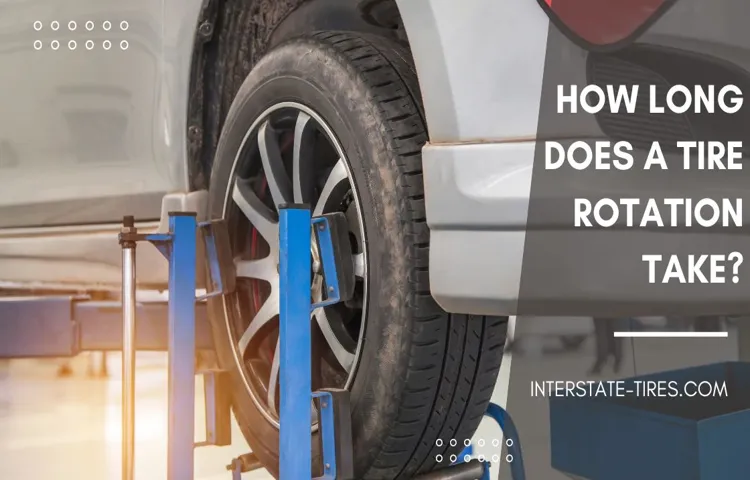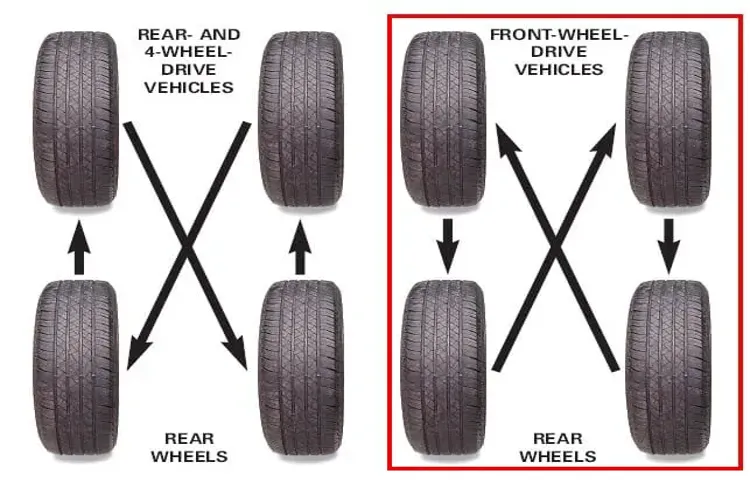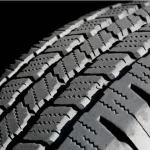Have you been wondering how long tire rotation takes? It’s a common question among car owners who prioritize the maintenance of their vehicles. The process involves changing the position of each tire, giving it a chance to wear down evenly. This simple procedure can extend the lifespan of your tires and improve your car’s overall performance.
But how long does it take and what factors should you consider before booking an appointment? Let’s dive into the details and find out.
Table of Contents
What is a Tire Rotation?
If you’ve ever wondered “how long does it take to do a tire rotation?” well, it depends on the mechanic and their workload. However, it typically takes about 45 minutes to an hour. But what exactly is a tire rotation? Essentially, it involves moving the tires to a different position on your car to promote even wear.
This is important because tires wear at different rates depending on their location and various factors such as driving habits, road conditions, and vehicle weight distribution. By rotating the tires, you’ll help them last longer and save money in the long run. It’s generally recommended that you get your tires rotated every 6,000 to 8,000 miles, or every six months, whichever comes first.
This will not only prolong the life of your tires but also ensure that your vehicle handles properly and safely on the road. So, our advice is to schedule a tire rotation regularly and save yourself some headaches down the line.
Definition and Importance of Tire Rotation
Tire Rotation Tire rotation is the process of moving each tire position on a vehicle to another location. It involves changing the location of the front tires to the back and the back tires to the front. This is done because tires wear unevenly due to the weight distribution and suspension system of a vehicle.
By rotating the tires, they wear more evenly and last longer, which saves money in the long run. Tire rotation also improves a vehicle’s performance, handling, and fuel efficiency. It ensures that each tire will experience different wear patterns and distribute the wear evenly.
This will improve traction, reduce vibrations, and increase safety by improving the vehicle’s performance over time. Tire rotation is a simple and cost-effective way to extend the life of tires and keep a vehicle running smoothly. So, it is important to make tire rotation a part of your regular maintenance routine to get the most value out of your tires.

Factors Affecting Tire Rotation Time
When it comes to how long it takes to do a tire rotation, there are a few factors that can affect the timeframe. One of the biggest factors is the type of vehicle that you have. For example, larger vehicles like trucks and SUVs require more time for a tire rotation than smaller cars.
Another factor is the type of tires you have. If you have directional tires, they can only be rotated in one direction, which can add time to the process. Similarly, if you have a specialized tire like a run-flat or low-profile tire, it may require additional time and care to rotate properly.
Additionally, the experience and expertise of the technician doing the rotation can play a role in the time it takes. A more experienced technician may be able to complete the rotation more quickly and efficiently than a less experienced one. Ultimately, the amount of time it takes to do a tire rotation depends on these and other factors, as well as the specific needs of your vehicle.
However, a typical tire rotation usually takes around 30-45 minutes.
Number of tires to be rotated
When it comes to tire rotation, one question that often arises is how many tires need to be rotated. The answer is simple: it depends on the type of tire rotation being performed. In a standard tire rotation, all four tires are rotated, meaning that each tire will move to a new position on the vehicle.
However, in some cases, such as a front-to-back tire rotation, only two tires will be rotated. The factors that affect how many tires need to be rotated include the type of tire rotation being performed, the condition of the tires, and the type of vehicle you are driving. It’s important to consult your vehicle’s owner’s manual or a professional mechanic to determine which type of tire rotation is best for your vehicle and to ensure that your tires are properly maintained for optimal performance and longevity.
Type of vehicle and tires
When it comes to tire rotation time, there are a few factors at play, one of which is the type of vehicle you drive. If you drive a standard passenger car, you may need to rotate your tires every 5,000 to 7,000 miles. However, if you own a larger vehicle, such as an SUV or a truck, you may need to have your tires rotated more frequently.
This is because larger vehicles put additional strain on the tires due to their added weight and often have different tire sizes and configurations. Another factor to consider is the type of tires you have. If you’re using all-season tires, they tend to wear out faster than more specialized tires like summer or winter tires.
As a result, you may need to rotate them more often, especially if you live in an area with harsh weather conditions. Ultimately, it’s best to consult your vehicle’s owner manual or speak with a tire specialist to determine the best rotation schedule based on your specific vehicle and tire type.
Condition of tires and wheels
Tire Rotation Time The condition of your tires and wheels directly affects how often you should have your tires rotated. Factors such as tire wear, pressure, alignment, and balance all play a role in determining the optimal time for rotation. Generally, it is recommended to rotate your tires every 5,000 to 7,500 miles.
However, this can vary depending on the make and model of your vehicle, as well as your driving habits. For example, if you frequently drive on uneven surfaces or make sharp turns, you may need to rotate your tires more often. Ensuring that your tires are in good condition and balanced will not only improve your vehicle’s performance but also prolong their lifespan.
If you neglect to rotate your tires, you risk causing uneven wear which can lead to decreased handling, reduced gas mileage, and even a potential blowout. So, don’t skip out on regular tire maintenance- it can save you a lot of headaches and expenses in the long run.
Average Time for Tire Rotation
If you’re wondering how long it takes to do a tire rotation, the answer can vary depending on a few factors. On average, a tire rotation can take anywhere from 30 minutes to an hour to complete. However, if additional services are needed, such as a wheel alignment or balancing, it can take longer.
It’s important to note that tire rotations should be done every six months or 6,000 to 8,000 miles, whichever comes first. Regular tire rotations can improve the life of your tires, provide a smoother ride, and even improve fuel efficiency. So, while the time it takes to rotate your tires may seem like an inconvenience, it’s a necessary maintenance task to ensure the longevity and safety of your vehicle.
Estimated Time for Most Vehicles and Certified Mechanics
Getting your tires rotated is an essential aspect of vehicle maintenance, and it’s crucial to know how long this process takes. Certified mechanics can usually complete the tire rotation within 30-45 minutes, depending on the vehicle’s size, make, and model. However, larger vehicles like trucks and SUVs may take longer, up to an hour or more.
It’s recommended to rotate your tires every six months or every 5,000-7,500 miles, whichever comes first. This is because tire wear is not always even, and rotating the tires can help ensure they wear evenly and prolong their lifespan. Neglecting this maintenance task can lead to uneven tire wear, decreased traction, and reduced fuel efficiency.
So, don’t skip out on getting your tires rotated! It’s a quick and straightforward task that can keep your vehicle performing at its best.
Actual Time for DIY or Inexperienced Mechanics
When it comes to DIY or inexperienced mechanics performing a tire rotation, the average time it takes can vary. While the process may seem straightforward enough, there are several factors to consider that can affect the time it takes to complete. For example, the size and weight of the vehicle’s tires and wheels, the tools and equipment available, and the level of experience of the person performing the rotation can all play a role.
On average, a tire rotation can take anywhere from 30 minutes to an hour for an experienced mechanic. However, for someone who is doing it for the first time or doesn’t have as much experience, it may take longer. It’s important to take the time to properly rotate the tires to ensure optimal performance and longevity.
Rushing through the process may lead to mistakes, which could potentially cause damage to the tires or vehicle. If you’re planning on performing a tire rotation yourself, it’s a good idea to research the process beforehand and gather all the necessary tools and equipment. This will help you save time and avoid frustration during the process.
Additionally, taking the time to do the job right will save you money in the long run by extending the life of your tires.
Conclusion
Well, my dear friend, the time it takes to rotate a tire depends on many factors – the type of vehicle, the number of tires to be rotated, the experience of the technician, and even the alignment of the stars (just kidding!). But don’t worry, with today’s advanced technology and skilled professionals, a tire rotation can be done in a jiffy while you sit back and enjoy a refreshing cup of coffee. So, whether you’re in a hurry or taking your sweet time, remember that getting your tires rotated will ensure a smoother, safer, and longer-lasting drive.
And as the wise saying goes, “take care of your tires, and they’ll take care of you!”
Summary and Final Thoughts
Summary and Final Thoughts: Average Time for Tire Rotation Tire rotation is an important maintenance task that helps extend tire life and ensures optimal vehicle performance. It involves moving each tire to a different position on your car to even out wear patterns caused by uneven weight distribution and different driving conditions. While the specific time interval for tire rotation may vary depending on various factors such as the type of vehicle, tire wear, and driving habits, the general rule of thumb is to rotate tires every 5,000 to 7,500 miles.
However, some automakers recommend a shorter time interval, such as every 3,000 miles or six months, especially for high-performance cars or vehicles that constantly carry heavy loads. A regular tire rotation not only prolongs the life of your tires but also improves handling, traction, and fuel economy. It also allows you to detect potential problems such as misalignment, worn bearings, or bald spots that may pose safety risks.
Therefore, it’s essential to follow your manufacturer’s guidelines or consult a trusted mechanic to determine the ideal time for your tire rotation. By doing so, you can ensure that your wheels stay in tip-top shape and keep you safe on the road.
FAQs
What is tire rotation and why is it important?
Tire rotation is when tires are switched from one position to another on a vehicle. It is important because it promotes even tread wear and extends the life of the tires.
How often should I get a tire rotation?
It is recommended to get a tire rotation every 6,000 to 8,000 miles or every six months, whichever comes first.
Can I rotate my tires myself?
Yes, tire rotation can be done manually, but it is recommended to have it done by a professional to ensure proper alignment and tire balance.
How long does a tire rotation take?
A tire rotation usually takes about 30 minutes to an hour, depending on the vehicle and the type of tires.
Do all vehicles require tire rotation?
Yes, all vehicles can benefit from tire rotation to promote even tread wear and extend tire life.
What happens if I don’t get a tire rotation?
If you don’t rotate your tires, they will wear unevenly, causing a decrease in traction and an increase in the risk of a blowout.
Should I get an alignment with my tire rotation?
It is recommended to get an alignment done at the same time as a tire rotation to ensure proper tire wear and handling.



